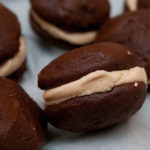
-
Rachel Marek
Combine flour, salt, and sugar in food processor:
In the bowl of a food processor, combine flour, salt, and sugar. Add butter, and process until the mixture resembles coarse meal, 8 to 10 seconds.
Rachel Marek
-
Add ice water and pulse:
With machine running, add ice water in a slow, steady stream through feed tube. Pulse until dough holds together without being wet or sticky; be careful not to process more than 30 seconds. To test, squeeze a small amount together: If it is crumbly, add more ice water, 1 tablespoon at a time.
Rachel Marek
-
Divide dough in half, flatten, and refrigerate:
Divide dough into two equal balls. Flatten each ball into a disc and wrap in plastic. Transfer to the refrigerator and chill at least 1 hour.
Rachel Marek
Storage
Chill the pâte brisée for a minimum of one hour before using. You can make it up to one day ahead and store it in the refrigerator. The pâte brisée dough can also be frozen for up to three months. Let it defrost overnight in the refrigerator before using.
Frequently Asked Questions
What is pâte brisée called in English?
There are several English names for the pastry dough called pâte brisée in French. In the U.K., it is called shortcrust pastry, a nod to its short or crumbly texture. In the U.S., it is generally called pie pastry or pie dough because it is most often used for pies.
What’s the difference between puff pastry and pâte brisée?
The main difference between puff pastry and pâte brisée is their texture. Both are made with flour and butter, but the proportion of butter is higher in puff pastry and the technique for making it is different. Puff pastry is made by folding butter between layers of dough, turning, rolling, and repeating to create a flaky pastry with layers. Pâte brisée is easier to make and has a more crumbly texture.
Rachel Marek Combine flour, salt, and sugar in food processor: In the bowl of a food processor, combine flour, salt, and sugar. Add butter, and process until the mixture resembles coarse meal, 8 to 10 seconds. Rachel Marek Add ice water and pulse: With machine running, add ice water in a slow, steady stream through feed tube. Pulse until dough holds together without being wet or sticky; be careful not to process more than 30 seconds. To test, squeeze a small amount together: If it is crumbly, add more ice water, 1 tablespoon at a time. Rachel Marek Divide dough in half, flatten, and refrigerate: Divide dough into two equal balls. Flatten each ball into a disc and wrap in plastic. Transfer to the refrigerator and chill at least 1 hour. Rachel Marek Storage Chill the pâte brisée for a minimum of one hour before using. You can make it up to one day ahead and store it in the refrigerator. The pâte brisée dough can also be frozen for up to three months. Let it defrost overnight in the refrigerator before using. Frequently Asked Questions What is pâte brisée called in English? There are several English names for the pastry dough called pâte brisée in French. In the U.K., it is called shortcrust pastry, a nod to its short or crumbly texture. In the U.S., it is generally called pie pastry or pie dough because it is most often used for pies. What’s the difference between puff pastry and pâte brisée? The main difference between puff pastry and pâte brisée is their texture. Both are made with flour and butter, but the proportion of butter is higher in puff pastry and the technique for making it is different. Puff pastry is made by folding butter between layers of dough, turning, rolling, and repeating to create a flaky pastry with layers. Pâte brisée is easier to make and has a more crumbly texture.
Strawberry Hand Pies









